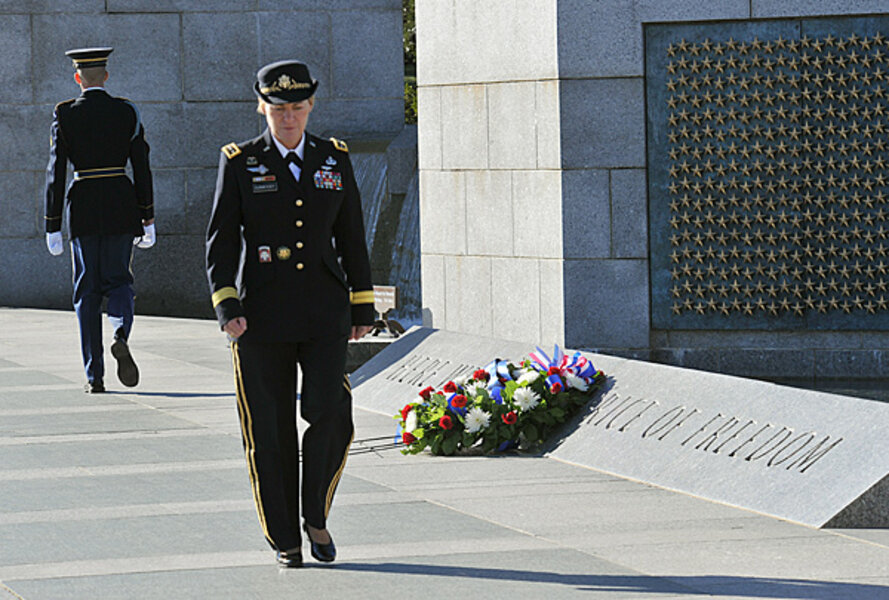Women serving in combat: US panel to recommend ban be lifted.
Loading...
| Washington
The Pentagon should allow women to serve in combat: That’s the conclusion of a US government commission made up of current and retired officers and senior noncommissioned officers.
The commission, established by Congress and the White House, is expected to send its recommendation to Capitol Hill and the White House in March.
Because they are not permitted to serve on the front lines, women – who make up 14 percent of the US armed forces – are routinely falling further behind men in their military careers, according to the nonpartisan Military Leadership Diversity Commission, charged with assessing whether the Pentagon promotes leaders who reflect the ranks of troops who serve beneath them.
The question has long been whether women are capable of handling the mental and physical rigors of combat. The commission pointed to long-standing concerns that “women in combat impede mission effectiveness because they cannot handle the same equipment or tolerate the same physical stress as men."
Yet in many cases, senior military officials point out, women already are. Gen. Peter Chiarelli, the Army’s Vice Chief of Staff, acknowledged this Wednesday when asked whether women should be allowed to serve in combat. “We have women in combat today,” he said.
What’s more, there are some indications that women may be more resilient than men, he added.
“I have not had an opportunity to look into that and dig into it, but I did look at our numbers for 2010 in women – women who committed suicide – and the numbers are very, very small. I believe we’re at somewhere in the vicinity of 7 percent, and that 93 percent are in fact males.... The resiliency of women – I may be out of school to state this – seems to be higher for whatever reason,” Charelli said.
What’s more, in the wars in Iraq and Afghanistan, restrictions on their service are often semantic, senior military officials noted. While women cannot be “assigned” to units likely to see combat, they can be “attached” to them and, in this way, fight in battles.
Such restrictions are largely outdated because of the types of wars America is fighting today, according to the commission’s draft report. The policies that bar women from combat “are based on the standards of conventional warfare, with well-defined linear battlefields. However, the current conflicts in Iraq and Afghanistan have been anything but conventional,” the report notes. “As a result, some of the military women deployed to Iraq and Afghanistan have already been engaged in activities that would be considered combat-related, including being co-located with combat units and engaging in direct combat.”
Among elected officials, feelings are mixed about women serving in combat. It has long been considered a politically dicey proposition, given concerns that should female casualties spike, the nation might quickly lose its appetite for war.
Within the military, too, there is division about the prospect. The commission notes that when men in the Army and the Marine Corps were asked about the combat exclusion policy, the majority said the gender exclusions should remain – and the percent increased with rank. However, those figures date from 1997, and senior officials suggest that the current wars have prompted shifts in thinking, and that men who have served with women have fewer misgivings about having them on the front lines.
Few women in the military support the combat exclusions. But debate continues among them over whether women should be able to volunteer for combat arms units, or whether they should be assigned to these units just like their male counterparts.
While the commission’s recommendations to the White House and Congress are slated to come in March, the issue of women in combat is not likely to be the Pentagon’s top priority in the months ahead, as it grapples with new budget constraints and integrating openly gay soldiers into the military.
"The appropriate folks here will thoroughly review and carefully consider the commission's recommendations, but frankly we are already in the midst of preparing for another significant cultural change, so that is where our focus is right now," Pentagon spokesman Geoff Morrell told Reuters.
Advocates tend to agree. “Given all of the emotional politics around 'don’t ask, don’t tell,' I don’t know to what extent politicians are going to take on women in the military in any large way,” says Anu Bhagwati, a former Marine captain and executive director of the Service Women's Action Network.
But they note that regardless of politics, women will continue to play a greater role on the front lines. “Women are in effect in direct ground combat everyday,” says Ms. Bhagwati.
“It’s exciting – all of the prohibitions on putting women on the so-called front lines are based so much on false stereotypes of women. The fact of the matter is that the more you segregate women in the military, the less exposure men have to women and the less they realize how talented they are,” she adds. “Politics may not catch up this year, but I fully expect to see progress on the battlefield.”





